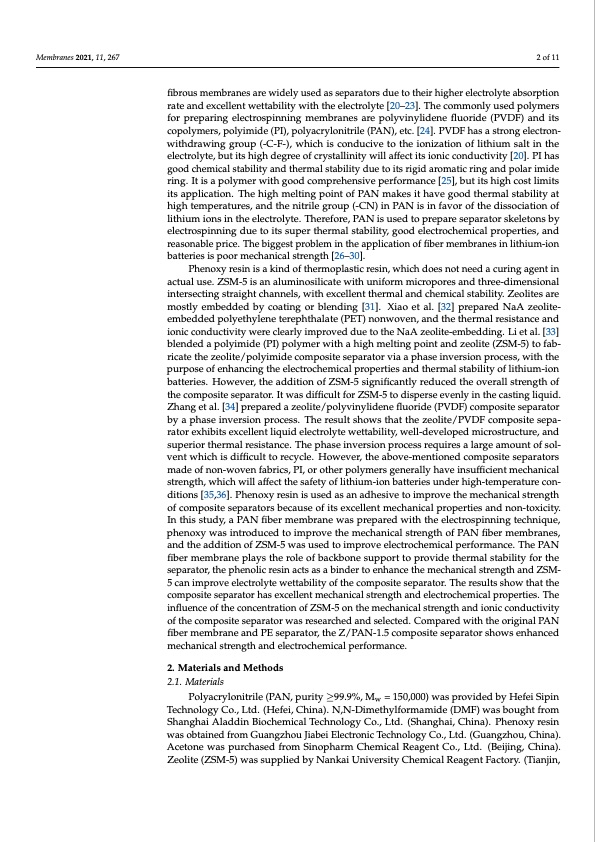
PDF Publication Title:
Text from PDF Page: 002
Membranes 2021, 11, 267 2 of 11 fibrous membranes are widely used as separators due to their higher electrolyte absorption rate and excellent wettability with the electrolyte [20–23]. The commonly used polymers for preparing electrospinning membranes are polyvinylidene fluoride (PVDF) and its copolymers, polyimide (PI), polyacrylonitrile (PAN), etc. [24]. PVDF has a strong electron- withdrawing group (-C-F-), which is conducive to the ionization of lithium salt in the electrolyte, but its high degree of crystallinity will affect its ionic conductivity [20]. PI has good chemical stability and thermal stability due to its rigid aromatic ring and polar imide ring. It is a polymer with good comprehensive performance [25], but its high cost limits its application. The high melting point of PAN makes it have good thermal stability at high temperatures, and the nitrile group (-CN) in PAN is in favor of the dissociation of lithium ions in the electrolyte. Therefore, PAN is used to prepare separator skeletons by electrospinning due to its super thermal stability, good electrochemical properties, and reasonable price. The biggest problem in the application of fiber membranes in lithium-ion batteries is poor mechanical strength [26–30]. Phenoxy resin is a kind of thermoplastic resin, which does not need a curing agent in actual use. ZSM-5 is an aluminosilicate with uniform micropores and three-dimensional intersecting straight channels, with excellent thermal and chemical stability. Zeolites are mostly embedded by coating or blending [31]. Xiao et al. [32] prepared NaA zeolite- embedded polyethylene terephthalate (PET) nonwoven, and the thermal resistance and ionic conductivity were clearly improved due to the NaA zeolite-embedding. Li et al. [33] blended a polyimide (PI) polymer with a high melting point and zeolite (ZSM-5) to fab- ricate the zeolite/polyimide composite separator via a phase inversion process, with the purpose of enhancing the electrochemical properties and thermal stability of lithium-ion batteries. However, the addition of ZSM-5 significantly reduced the overall strength of the composite separator. It was difficult for ZSM-5 to disperse evenly in the casting liquid. Zhang et al. [34] prepared a zeolite/polyvinylidene fluoride (PVDF) composite separator by a phase inversion process. The result shows that the zeolite/PVDF composite sepa- rator exhibits excellent liquid electrolyte wettability, well-developed microstructure, and superior thermal resistance. The phase inversion process requires a large amount of sol- vent which is difficult to recycle. However, the above-mentioned composite separators made of non-woven fabrics, PI, or other polymers generally have insufficient mechanical strength, which will affect the safety of lithium-ion batteries under high-temperature con- ditions [35,36]. Phenoxy resin is used as an adhesive to improve the mechanical strength of composite separators because of its excellent mechanical properties and non-toxicity. In this study, a PAN fiber membrane was prepared with the electrospinning technique, phenoxy was introduced to improve the mechanical strength of PAN fiber membranes, and the addition of ZSM-5 was used to improve electrochemical performance. The PAN fiber membrane plays the role of backbone support to provide thermal stability for the separator, the phenolic resin acts as a binder to enhance the mechanical strength and ZSM- 5 can improve electrolyte wettability of the composite separator. The results show that the composite separator has excellent mechanical strength and electrochemical properties. The influence of the concentration of ZSM-5 on the mechanical strength and ionic conductivity of the composite separator was researched and selected. Compared with the original PAN fiber membrane and PE separator, the Z/PAN-1.5 composite separator shows enhanced mechanical strength and electrochemical performance. 2. Materials and Methods 2.1. Materials Polyacrylonitrile (PAN, purity ≥99.9%, Mw = 150,000) was provided by Hefei Sipin Technology Co., Ltd. (Hefei, China). N,N-Dimethylformamide (DMF) was bought from Shanghai Aladdin Biochemical Technology Co., Ltd. (Shanghai, China). Phenoxy resin was obtained from Guangzhou Jiabei Electronic Technology Co., Ltd. (Guangzhou, China). Acetone was purchased from Sinopharm Chemical Reagent Co., Ltd. (Beijing, China). Zeolite (ZSM-5) was supplied by Nankai University Chemical Reagent Factory. (Tianjin,PDF Image | Electrospinning Polyacrylonitrile Separator with Dip-Coating of Zeolite

PDF Search Title:
Electrospinning Polyacrylonitrile Separator with Dip-Coating of ZeoliteOriginal File Name Searched:
membranes-11-00267.pdfDIY PDF Search: Google It | Yahoo | Bing
CO2 Organic Rankine Cycle Experimenter Platform The supercritical CO2 phase change system is both a heat pump and organic rankine cycle which can be used for those purposes and as a supercritical extractor for advanced subcritical and supercritical extraction technology. Uses include producing nanoparticles, precious metal CO2 extraction, lithium battery recycling, and other applications... More Info
Heat Pumps CO2 ORC Heat Pump System Platform More Info
| CONTACT TEL: 608-238-6001 Email: greg@infinityturbine.com | RSS | AMP |